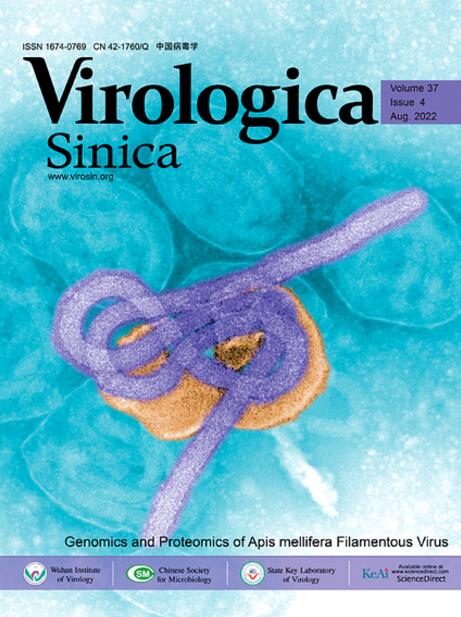Identification of mutations in viral proteins involved in cell adaptation using a reverse genetic system of the live attenuated hepatitis A virus vaccine H2 strain
IF 4
3区 医学
Q1 Medicine
引用次数: 0
Abstract
The live attenuated hepatitis A virus vaccine H2 strain was developed by passaging a wild-type H2w isolate in cell cultures. Currently, the mechanism underlying its attenuation phenotype remain largely unknown. In this study, we generated a full-length infectious cDNA clone of the H2 strain using in-fusion techniques. The recovered H2 strain (H2ic) from the cDNA clone exhibited an efficient replication in both the hepatoma cell line Huh7.5.1 and the 2BS cell line used for vaccine production, similar to the parental H2 strain. Additionally, H2ic did not cause disease in Ifnar1−/− C57 mice, consistent with the H2 strain. To explore the cell-adaptive mutations of the H2 strain, chimeric viruses were generated by replacing its non-structural proteins with corresponding regions from H2w using the infectious cDNA clone as a genetic backbone. The chimeric viruses carrying the 3C or 3D proteins from H2w showed decreased replication in Huh7.5.1 and 2BS cell lines compared to H2ic. Other chimeric viruses containing the 2B, 2C, or 3A proteins from H2w failed to be recovered. Furthermore, there were no significant differences in disease manifestation in mice between H2ic and the recovered chimeric viruses. These results demonstrate that adaptive mutations in the 2B, 2C, and 3A proteins are essential for efficient replication of the H2 strain in cell cultures. Mutations in the 3C and 3D proteins contribute to enhanced replication in cell cultures but did not influence the attenuated phenotypes in mice. Together, this study presents the first reverse genetic system of the H2 strain and identifies viral proteins essential for adaptation to cell cultures.
利用甲型肝炎病毒减毒活疫苗 H2 株的反向遗传系统鉴定参与细胞适应的病毒蛋白变异。
甲型肝炎病毒减毒活疫苗 H2 株是通过将野生型 H2w 分离物在细胞培养物中传代培养出来的。目前,其减毒表型的基本机制仍不清楚。在本研究中,我们利用内融合技术生成了 H2 株的全长感染性 cDNA 克隆。从该 cDNA 克隆中回收的 H2 株(H2ic)在肝癌细胞系 Huh7.5.1 和用于生产疫苗的 2BS 细胞系中均表现出高效复制,与亲本 H2 株相似。此外,H2ic 在 Ifnar1-/- C57 小鼠中不会致病,这与 H2 株一致。为了探索 H2 株的细胞适应性突变,我们以感染性 cDNA 克隆为基因骨架,用 H2w 的相应区域取代其非结构蛋白,生成了嵌合病毒。与 H2ic 相比,携带 H2w 的 3C 或 3D 蛋白的嵌合病毒在 Huh7.5.1 和 2BS 细胞系中的复制能力下降。其他含有 H2w 的 2B、2C 或 3A 蛋白的嵌合病毒则未能恢复。此外,H2ic 和回收的嵌合病毒在小鼠的疾病表现上没有明显差异。这些结果表明,2B、2C 和 3A 蛋白的适应性突变对于 H2 株在细胞培养物中的有效复制至关重要。3C和3D蛋白的突变有助于增强细胞培养物中的复制,但并不影响小鼠体内的减弱表型。总之,这项研究首次提出了 H2 株的反向遗传系统,并确定了适应细胞培养所必需的病毒蛋白。
本文章由计算机程序翻译,如有差异,请以英文原文为准。
求助全文
约1分钟内获得全文
求助全文
来源期刊

Virologica Sinica
Biochemistry, Genetics and Molecular Biology-Molecular Medicine
CiteScore
7.70
自引率
1.80%
发文量
3149
期刊介绍:
Virologica Sinica is an international journal which aims at presenting the cutting-edge research on viruses all over the world. The journal publishes peer-reviewed original research articles, reviews, and letters to the editor, to encompass the latest developments in all branches of virology, including research on animal, plant and microbe viruses. The journal welcomes articles on virus discovery and characterization, viral epidemiology, viral pathogenesis, virus-host interaction, vaccine development, antiviral agents and therapies, and virus related bio-techniques. Virologica Sinica, the official journal of Chinese Society for Microbiology, will serve as a platform for the communication and exchange of academic information and ideas in an international context.
Electronic ISSN: 1995-820X; Print ISSN: 1674-0769
 求助内容:
求助内容: 应助结果提醒方式:
应助结果提醒方式:


